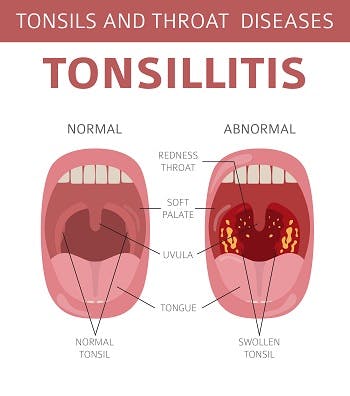
When you or a family member presents with a respiratory infection it’s rather difficult to be able to tell which one it is. This is because many of them share similar symptoms. So how do you know whether you are dealing with tonsillitis, the influenza virus, or strep throat? Turning to an otolaryngologist can give you the answers and the relief you’re looking for.
What is tonsillitis?
The two lymph nodes located on both sides of the back of the throat are known as tonsils. They are the body’s first defense against preventing infection; however, even tonsils can become infected and when they do this is known as tonsillitis.
Tonsillitis can happen to anyone but is more common in children and teens. Tonsillitis is contagious, so it can easily spread if you come in contact with someone who is infected. There are three main types of tonsillitis: acute, chronic and recurrent. Most children will develop acute tonsillitis at least once during their lifetime.

What are the symptoms of tonsillitis?
Symptoms of tonsillitis may include:
- A severe sore throat
- Trouble or pain with swallowing
- Hoarseness
- Earaches
- Headaches
- Fever
- Chills
- Persistent bad breath
- Swollen, tender lymph nodes of the neck and jaw
- Red, swollen tonsils
- White or yellow spots on the tonsils
Symptoms of acute tonsillitis usually go away within 7-10 days; however, if symptoms keep coming back throughout the year then your child could very well be dealing with recurrent or chronic tonsillitis. It’s important that if symptoms of tonsillitis worsen or return that you see an ENT doctor.
Furthermore, it isn’t always easy to tell whether a sore throat is the result of a cold, tonsillitis or strep throat; however, sore throats caused by colds are usually mild and will get better within a couple of days. This type of sore throat will often be accompanied by other cold symptoms such as a runny nose.
If your sore throat is caused by tonsillitis or strep the pain will be severe and can make it difficult to swallow. Those with tonsillitis may experience pain located in the back of the throat, where the tonsils are located. In order to diagnose a strep throat your doctor will need to swab the back of the throat to look for bacteria.
How is tonsillitis treated?
Acute tonsillitis will go away on its own but rest and home care can go a long way to relieving symptoms; however, if tonsillitis is caused by a bacterial infection such as strep, your doctor will need to prescribe a round of antibiotics.
If your child is dealing with chronic or recurring tonsillitis then you may want to talk with your ear, nose and throat doctor about the benefits of having their tonsils removed (known as a tonsillectomy). This is a simple surgical procedure that can often be performed right in your otolaryngologist’s office.
If your child is dealing with severe throat pain and you’re worried that they could have tonsillitis then call your ENT specialist today for an immediate evaluation.

